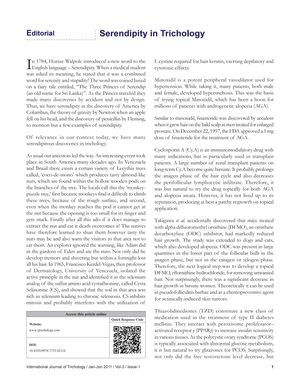Serendipity in Trichology
January 2011
in “
International Journal of Trichology
”

TLDR Accidental findings have led to new hair treatment discoveries, like using blood pressure and diabetes medications for hair loss and unwanted hair.
The document discusses the concept of serendipity in the field of trichology, highlighting several accidental discoveries that have significantly impacted the treatment of hair-related conditions. The active principle in a nut from the 'coco-de-mono' tree was found to cause hair loss due to its selenium content, leading to the discovery of the compound Cysta Selinonine (CS) which inhibits mitosis in hair keratin. Minoxidil, originally a hypertension medication, was found to cause hypertrichosis, leading to its use as a topical treatment for androgenetic alopecia (AGA). Similarly, finasteride was approved for AGA treatment after it promoted hair growth in men treated for enlarged prostate. Cyclosporin A (Cy.A), used in transplant patients, was observed to increase hair growth, although it did not prove effective as a topical treatment for AGA or alopecia areata. An ornithine decarboxylase inhibitor, alpha difluoromethyl ornithine (DFMO), was found to reduce hair growth in animals, leading to the development of a topical treatment for unwanted hair in hirsute women. Lastly, thiazolidinediones (TZD), used for type II diabetes, were found to improve hirsutism in polycystic ovary syndrome (PCOS) and play a role in treating lichen plano pilaris (LPP). The document emphasizes the importance of observation and preparedness in making serendipitous discoveries in dermatology.


